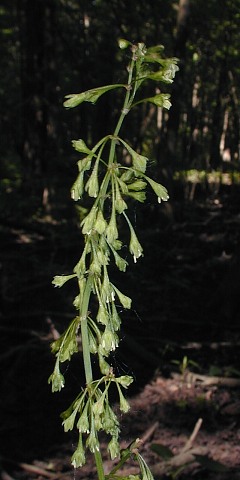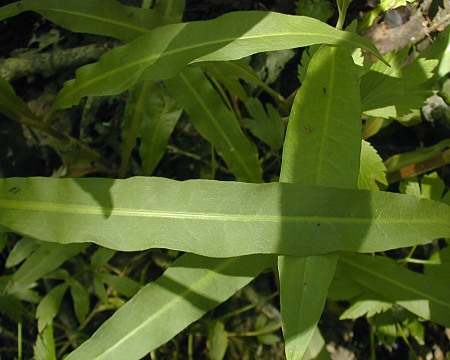 Description:
This perennial plant is 3-5' tall and unbranched or sparingly so. The
central stem is light green to reddish green, hairless, and terete. The
alternate leaves are up to 12" long and 2½" across, becoming smaller as
they ascend the stem. The lowest leaves have petioles about as long as
the blade, while the middle to upper leaves have short petioles. At the
base of each petiole, there is a papery sheath that wraps around the
stem. Each leaf is oblong-lanceolate, smooth or slightly undulate along
the margins, and hairless; the margins are not crisped. The central
stem terminates in 1-4 whorled racemes of greenish flowers; each raceme
is up to 12" long. Each flower consists of 6 tepals, 6 stamens, and a
tripartite style; it is about 1/8" across. The tepals are green, while
the anthers of the stamens are white or pale yellow. Each flower droops
downward from a slender pedicel that is up to 2/3" (16 mm.) long. The
blooming
period occurs during the summer and lasts about 2 weeks. Pollination is
by the agency of the wind. Each flower is replaced by a 3-valved fruit
up to 1/6" (4 mm.) long when it is fully mature. Each valve is a
modified inner
sepal; it is deltoid-ovate, flattened, and smooth along the margins.
Each valve encloses a lanceolate tubercle that is located along the
upper-half of its central vein. Each tubercle contains a single achene
(or grain); there are 3 achenes per fruit. Each achene is reddish brown
and shiny. The 3-valved fruits persist into the fall, at which time
they detach from the mother plant; these detached fruits can be blown
about by the wind or float on water, distributing the achenes. The root
system consists of a taproot.
Description:
This perennial plant is 3-5' tall and unbranched or sparingly so. The
central stem is light green to reddish green, hairless, and terete. The
alternate leaves are up to 12" long and 2½" across, becoming smaller as
they ascend the stem. The lowest leaves have petioles about as long as
the blade, while the middle to upper leaves have short petioles. At the
base of each petiole, there is a papery sheath that wraps around the
stem. Each leaf is oblong-lanceolate, smooth or slightly undulate along
the margins, and hairless; the margins are not crisped. The central
stem terminates in 1-4 whorled racemes of greenish flowers; each raceme
is up to 12" long. Each flower consists of 6 tepals, 6 stamens, and a
tripartite style; it is about 1/8" across. The tepals are green, while
the anthers of the stamens are white or pale yellow. Each flower droops
downward from a slender pedicel that is up to 2/3" (16 mm.) long. The
blooming
period occurs during the summer and lasts about 2 weeks. Pollination is
by the agency of the wind. Each flower is replaced by a 3-valved fruit
up to 1/6" (4 mm.) long when it is fully mature. Each valve is a
modified inner
sepal; it is deltoid-ovate, flattened, and smooth along the margins.
Each valve encloses a lanceolate tubercle that is located along the
upper-half of its central vein. Each tubercle contains a single achene
(or grain); there are 3 achenes per fruit. Each achene is reddish brown
and shiny. The 3-valved fruits persist into the fall, at which time
they detach from the mother plant; these detached fruits can be blown
about by the wind or float on water, distributing the achenes. The root
system consists of a taproot.
Cultivation:
The preference is light shade to full sun, wet conditions, and mucky to
sandy
soil. This plant can tolerate standing water better than most Docks
(Rumex spp.). It also tolerates shade better than most Docks.
Range & Habitat:
The native Swamp Dock (Rumex verticillatus) is occasional to locally common in most areas of
Illinois;
it is least common in SE Illinois (see Distribution
Map). Habitats include edges of vernal pools and streams in
woodlands, swamps, soggy islands in partially shaded areas, marshes,
and roadside ditches.
Faunal Associations:
Insects that feed on the foliage and/or other parts of Docks (Rumex
spp.) include the Green Dock Beetle (Gastrophysa cyanea) and other leaf
beetles, Rhubarb Weevil (Lixus concavus) and other weevils, larvae of
Anthomyiid flies (Pegomya spp.), larvae of the Dock Seed Midge
(Contarinia rumicis), plant bugs, stink bugs, Dock Aphid (Aphis
rumicis) and other aphids, mealy bugs, larvae of the Dock Sawfly
(Ametastegia glabrata) and other sawflies (Ametastegia spp.), larvae of
the Rustic Dock (Luperina passer) and other moths, larvae of copper
butterflies (Lycaena spp.), and the Sword-bearing Conehead
(Neoconocephalus ensiger). The Insect Table
has a more complete list of these species. Among vertebrate animals,
such birds as the Swamp Sparrow, Song Sparrow, Red-winged Blackbird,
and Bobolink feed on the seeds of wetland species of Docks (Martin et
al., 1951/1961). White-tailed Deer occasionally browse on the foliage
of Swamp Dock (Rumex verticillatus) in wooded swampy areas (personal
observation), while Muskrats and Meadow Voles use these plants as a
minor source of food (Martin et al., 1951/1961; Hamerstrom & Blake,
1939). Livestock feed on the foliage of Docks, but the nitrates and
oxalates in the leaves are mildly poisonous if they are eaten in
quantity.

Photographic
Location:
At the edge of a vernal pool in Busey Woods of Urbana, Illinois. The
flowers in the upper photograph are starting to form fruits.
Comments:
This tall slender plant is often found in shady wetlands, but it also
occurs in sunny places. While the
flowers are not showy, this plant is relatively conspicuous because of
its size. Distinguishing the different species of Dock (Rumex spp.)
that occur in Illinois is relatively difficult. However, Swamp
Dock can be identified by the long drooping pedicels of the
flowers/fruits; these pedicels are 2-5 times longer than their attached
fruits. Other Docks in Illinois have pedicels that are no longer than
twice the
length of their fruits. Other key features of Swamp Dock include: 1)
the margins of its mature leaves are flat rather than crisped, 2) each
of its
fruits has 3 tubercles/achenes, and 3) the margins of the valves on its
fruits are
smooth (they lack teeth). Another native species, Pale Dock (Rumex
altissimus), has a somewhat similar appearance to
Swamp Dock, but it has shorter pedicels and each of its fruits has a
single tubercle/achene.